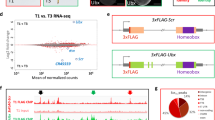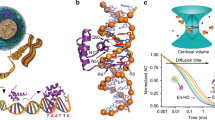Abstract
TWO yeast homeodomain proteins, al and α2, interact and cooperatively bind the haploid-specific gene (hsg) operator, resulting in the repression of a set of genes involved in the determination of cell type1–5. The cooperative binding of al and α2 to DNA can be reconstituted in vitro using purified fragments of al and α2. Only the homeodomain is needed for al, but for α2 a C-terminal 22-amino-acid tail is required as well4,6–9. As most of the specificity of DNA binding appears to derive from al, we proposed4 that α2 functions in the al/α2 heterodimer to contact al with its tail. By construction and analysis of several chimaeric proteins, we investigate how two DNA-binding proteins, one with low intrinsic specificity (α2) and one with no apparent intrinsic DNA-binding ability (al), can together create a highly specific DNA-binding activity4. We show that the 22-amino-acid region of α2 immediately C-terminal to the homeodomain, when grafted onto the al homeodomain, converts al to a strong DNA-binding protein. This α2 tail can also be attached to the Drosophila engrailed homeodomain, and the chimaeric protein now binds cooperatively to DNA with al, showing how a simple change can create a new homeodomain combination that specifically recognizes a new DNA operator.
This is a preview of subscription content, access via your institution
Access options
Subscribe to this journal
Receive 51 print issues and online access
$199.00 per year
only $3.90 per issue
Buy this article
- Purchase on Springer Link
- Instant access to full article PDF
Prices may be subject to local taxes which are calculated during checkout
Similar content being viewed by others
References
Strathern, J. N., Hicks, J. & Herskowitz, I. J. molec. Biol. 147, 357–372 (1981).
Goutte, C. & Johnson, A. D. Cell 52, 875–882 (1988).
Dranginis, A. M. Nature 347, 682–685 (1990).
Goutte, C. & Johnson, A. D. J. molec. Biol. 233, 359–371 (1993).
Goutte, C. & Johnson, A. D. EMBO J. 13, 1434–1442 (1994).
Mak, A. & Johnson, A. D. Genes Dev. 7, 1862–1870 (1993).
Strathern, J., Shafer, B., Hicks, J. & McGill, C. Genetics 120, 75–81 (1988).
Goutte, C. & Johnson, A. D. EMBO J. 13, 1434–1442 (1994).
Philips, C. L., Stark, M. R., Johnson, A. D. & Dahlquist, F. W. Biochemistry 33, 9294–9302 (1994).
Goutte, C. Combinatorial Control of the Yeast Homeodomain Proteins a1 and α2 (UCSF Press, San Francisco, 1992).
Philips, C. L., Vershon, A. K., Johnson, A. D. & Dahlquist, F. W. Genes Dev. 5, 764–772 (1991).
Wolberger, C., Vershon, A. K., Liu, B., Johnson, A. D. & Pabo, C. O. Cell 67, 517–528 (1991).
Johnson, A. D. in Transcriptional Regulation (eds McKnight, S. L. & Yamamoto, K. R.) 975–1005 (Cold Spring Harbor Laboratory Press, Plainview, 1992).
Vershon, A. K. & Johnson, A. D. Cell 72, 105–112 (1993).
Xue, D., Tu, Y. & Chalfie, M. Science 261, 1324–1328 (1993).
Chan, S.-K. & Mann, R. S. Genes Dev. 7, 796–811 (1993).
Lin, L. & McGinnis, W. Genes Dev. 6, 1071–1081 (1992).
Kissinger, C. R., Liu, B., Martin-Bianco, E., Kornberg, T. B. & Pabo, C. O. Cell 63, 579–590 (1990).
Hall, M. N. & Johnson, A. D. Science 237, 1007–1012 (1987).
Sauer, R. T., Smith, D. L. & Johnson, A. D. Genes Dev. 2, 807–816 (1988).
Mullis, K. B. et al. Cold Spring Harbor Symp. quant. Biol. 51, 263–273 (1986).
Higuchi, R. in PCR Protocols: A Guide to Methods and Applications (eds Innis, M. A., Gelfand, D. H., Sninsky, J. J. & White, T. J.) 177–183 (Academic, San Diego, 1990).
Studier, F. W. & Moffatt, B. A. J. molec. Biol. 189, 113–130 (1986).
Smith, D. L. & Johnson, A. D. Cell 68, 133–142 (1992).
Author information
Authors and Affiliations
Rights and permissions
About this article
Cite this article
Stark, M., Johnson, A. Interaction between two homeodomain proteins is specified by a short C-terminal tail. Nature 371, 429–432 (1994). https://doi.org/10.1038/371429a0
Received:
Accepted:
Issue Date:
DOI: https://doi.org/10.1038/371429a0
This article is cited by
-
Solution NMR structures of homeodomains from human proteins ALX4, ZHX1, and CASP8AP2 contribute to the structural coverage of the Human Cancer Protein Interaction Network
Journal of Structural and Functional Genomics (2014)
-
Cooperative DNA-binding and sequence-recognition mechanism of aristaless and clawless
The EMBO Journal (2010)
-
The conserved ELK-homeodomain of KNOTTED-1 contains two regions that signal nuclear localization
Plant Molecular Biology (1996)
Comments
By submitting a comment you agree to abide by our Terms and Community Guidelines. If you find something abusive or that does not comply with our terms or guidelines please flag it as inappropriate.



